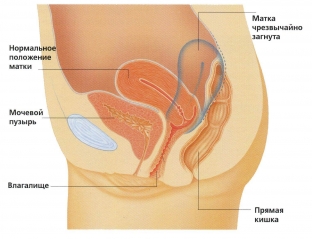Each person is unique, despite the general principles of the anatomy and physiology of the human body. But in the body of each of us there are peculiarities of the location, structure and functioning of organs. Sometimes they can be beneficial to us, and sometimes they are a pathological condition. The bend of the uterus is an anatomical feature of the location of the internal female genital organs, which can be congenital or acquired. Normally, the uterus is located in the pelvic cavity between the bladder and the rectum, but it can change its position depending on the change in the state of nearby organs.
Causes, symptoms and treatments for uterine tilt
Tilting of the uterus occurs in about one in five women. A bend is considered a divergence of the axes of the uterus in parallelism and a decrease in the angle between the body and the cervix to 90-110 °.
Deviation can be observed anteriorly, posteriorly, to the right or left, but in 70% of cases there is a bend of the uterus exactly forward or backward.
Patients are primarily concerned about the possibility of getting pregnant and bearing a child with such an anomaly in the position of the uterus. Estet-portal.com knows that there is no single answer to this question, everything is strictly individual. The ability to have a normal sexual life and conceive a child in patients with uterine inversion depends, first of all, on the severity of the pathological condition.
Uterine fold:
- causes of congenital and acquired bending of the uterus;
- clinical picture with uterine bend: characteristic symptoms;
- effective treatments for uterine tilt.
Causes of congenital and acquired bending of the uterus
Tilting of the uterus can be congenital or acquired. Congenital bending of the uterus, due to genetic pathology, is quite common and is combined with underdevelopment of the uterus. Among the main acquired causes of the development of uterine bending can be identified:
- weakness of the ligaments holding the uterus;
- deliveries complicated by rupture of the pelvic muscles;
- frequent constipation or constant suppression of the urge to empty the bladder and defecate;
- adhesions in the pelvis;
- ovarian cysts;
- tumors of the uterus, bladder and intestines;
- endometriosis.
Clinical picture of the bend of the uterus: characteristic symptoms
The clinical picture of the bend of the uterus depends on the severity of the anomaly itself. With a slight bend, the patient may not be bothered by anything for a long time, and the first symptom of the disease may be infertility or miscarriage. With a greater deformation of the uterus, the signs of pathology are more pronounced. One of the main complaints of such patients is discomfort or pain during intercourse. Pain can also occur with prolonged walking, running, or a sudden change in body position. There are violations of the menstrual cycle, which are manifested by severe pain, heavy menstrual bleeding and spotting before menstruation. If the deformed uterus compresses the rectum, frequent constipation may occur.

Effective treatments for uterine tilt
With a small congenital bend of the uterus and the absence of pronounced symptoms of pathology, specific treatment is not required. In other cases, the treatment of uterine bending is based primarily on the elimination of the causative factor. For this purpose, the following may be appointed:
- vitamin and physiotherapy;
- taking anti-inflammatory drugs;
- physiotherapy exercises to train the muscles of the small pelvis;
- gynecological massage.
In severe cases, the patient may need surgery to eliminate the cause of the uterine tilt and fix the organ in a physiological position.
An individual approach in each case makes it possible to adequately assess the clinical situation and effectively cure the uterine inversion.






Add a comment